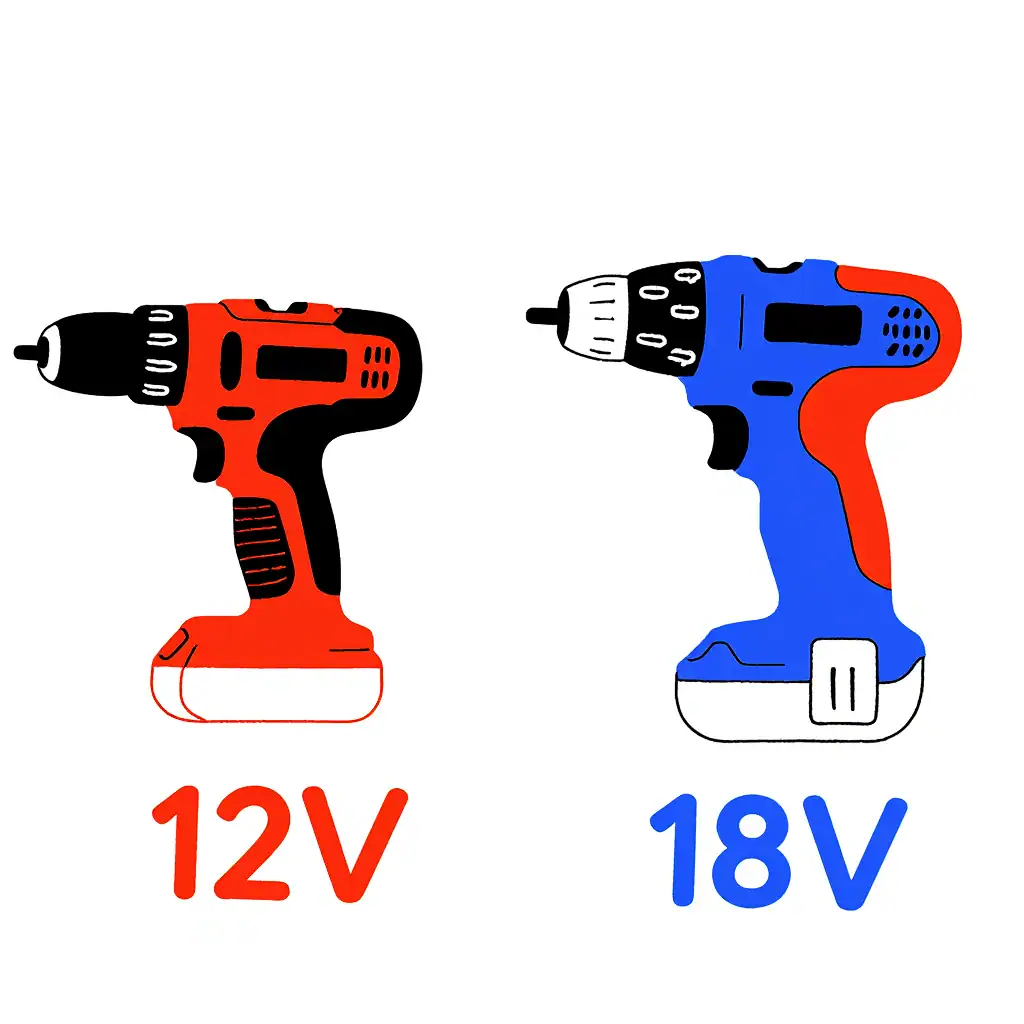Look, last year I tried to assemble a giant flat-pack wardrobe with a dinky little electric screwdriver—it was a disaster and my wrist was sore for a week, which taught me fast that the right drill isn’t a luxury, it’s sanity for Saturday projects. Since then, I’ve kept a compact 12V Bosch for 90% of indoor jobs and an 18V DeWalt for the moments when wood, brick, or big screws refuse to cooperate. Size, weight, and torque are trade-offs that matter in the real world. My “wow” moment was sneaking the 12V into a tight cabinet hinge where the 18V wouldn’t even fit, and my “ugh” moment was stalling the 12V on a run of 3-inch screws in pressure-treated lumber until the 18V muscled through like butter. 👍
12V vs 18V: At a Glance
| Factor | 12V Drill | 18V Drill |
|---|---|---|
| Power/Torque | Enough for most indoor tasks; can bog down in dense lumber or masonry. | Higher torque for long screws, large hole saws, and deck work. |
| Size/Weight | Smaller, lighter, easier overhead and in tight spaces. | Bulkier and heavier; less friendly in cramped spots. |
| Runtime | Smaller batteries but efficient for light tasks; quick to charge. | Supports larger batteries with longer runtime under heavy load. |
| Cost/Platform | Lower cost of entry; fewer tool types available on the platform. | Higher upfront cost; widest tool ecosystems for expansion. |
Power: What Really Changes the Job
- 12V drills have adequate torque for drywall, studs with pilot holes, furniture assembly, and hardware. They will stall or slow down on long deck screws, big spade bits, and hole saws in thick wood because voltage correlates with available torque.
- 18V drills carry more torque and tolerate heavy loads longer, making them the right call for pressure-treated lumber, masonry anchors, and large diameter bits where a 12V would overheat or drain fast.
Size and Weight: The Stealth Advantage
- 12V tools are meaningfully smaller and lighter. This matters when you’re reaching inside cabinets, working overhead, or squeezing between studs. That maneuverability is often the difference between a one-handed fix and a fight.
- 18V tools are bigger and heavier. This improves control at high torque but makes them clumsy in tight interiors. This is why pros and serious DIYers often keep both and grab the smallest tool that can actually do the job.
Cost and Platform: Where Your Money Goes
- 12V systems are cheaper to start with and perfect as a “household kit.” However, the platform has fewer saws and high-demand tools if you plan on expanding your collection later.
- 18V platforms cost more up front but have the deepest ecosystems. They support larger batteries for long runtime, which pays off if future tools like circular saws, grinders, or hammer drills are on your wish list.
Pros and Cons

12V Drills
- Pros: Compact, light, easy in tight spaces, great for 90% of indoor homeowner tasks.
- Cons: Less torque, can stall on long screws and dense materials, smaller platform of tools.
- Cordless Drill Set: The VIWKO 12V cordless drill is your perfect companion for tackling a variety of tasks around your home, garden, garage, DIY projects, and workshops. With this versatile tool, you can easily install cabinets, hang pendant lights, frame pictures, and tighten or loosen screws with ease.
- Electric Power Drill: Compared to most 12V drills, the VIWKO 12V cordless drill has a more powerful torque of 250 inches pounds; Equipped with 25+1 torque setting, it can achieve more precise control. Variable speed trigger can cope with more usage scenarios.
- High Practicality: Work comfortably in any environment with the VIWKO drill set. The high-brightness LED lights provide excellent visibility, even in dark spaces; Directional rotation button moves to the middle, the drill enters safety mode; moving left or right can freely switch the rotation direction between clockwise and counterclockwise; The ergonomic handle design offers a comfortable grip for extended use.
- Power Pack & Fast Charger: The VIWKO drill driver comes with a 2.0Ah power pack, providing long-lasting power for your tasks. The new protection chip ensures comprehensive protection against overshoot, overcurrent, and overvoltage. With the included fast charger, you can quickly charge the power pack in just 1 hour, minimizing downtime.
- What's Include? This drill kit includes everything you need to get started. It comes with 10 drill bits, 10 screwdriver bits, 10 screws, 10 wall anchors, 1 extended bar, 1 flexible shaft driver, and 1 fast charger. The 3/8-inch keyless chuck allows for easy accessory replacement. Start your projects with confidence using the VIWKO cordless drill set!
- High-Performance Power Drill Set: FADAKWALT cordless drill with superior motor, 180 in-lbs (19 N.m) of max torque is perfect for drilling wood, metal, plastics, and all screw driving tasks at home; Precise control settings prevent stripping
- 21+1 Position Clutch: 21+1 torque settings (0-650 RPM ) of power drill can provide more precise torque or speed adjustment as required, which helps to prevent sinking a screw too deep, stripping out the head of a screw or even breaking a screw shaft
- Ergonomic Design: Compact and lightweight, with a superior motor, minimizes fatigue in most daily screwing and drilling tasks; The rubber grip ensures comfort for one-handed operation; The LED light and electric brake ensure precise work in dark areas
- Package List: You will get, 1 x Cordless Drill ,1 x Charger,1 x Magnetic Flexible Shaft, 1 x Extension Bar for Sticking on Fastener,3 x Wood Drill Bits,3 x Masonry Drill Bits,10 x 25 mm screwdriver bits, 1 x Screw anchor set
- Customer Service: If your Cordless Power Drill has quality problems or have any questions, please feel free to contact with us, we are always here
- Keyless chuck for quick and easy bit changes
- Compact and lightweight to fit into tight spaces
- 11 position clutch for precision control
- LED work light illuminates the surface for easier drilling in dark places
18V Drills
- Pros: High torque for heavy-duty tasks, broader tool ecosystem, longer runtime with big batteries.
- Cons: Heavier and bulkier, overkill for many indoor tasks, higher cost of entry.
- Compact, lightweight design fits into tight areas
- High performance motor delivers 300 unit watts out (UWO) of power ability completing a wide range of applications
- High speed transmission delivers two speeds (0-450 & 1,500 rpm) for a range of fastening and drilling applications
- Powerful 20 V Motor and 2 x 1.5 Ah Battery: Equipped with a robust 20 V motor and 2 Li-ion battery, this cordless drill delivers smooth power for various drilling and driving tasks;Its rechargeable battery ensures you're always ready for next project
- 2 Variable Speed Settings for Versatility: With two speed options (0-400, 0-1500 RPM ), this drill provides ultimate control over your applications; Perfect for both delicate tasks and heavy-duty jobs, you can easily adjust the speed to match your needs
- Robust 266 In-lb (30 N.m) Torque and 21+1 Settings: With a maximum torque of 266 In-lb (30 N.m) and 21+1 adjustable settings, this drill excels in precision and ease; It prevents over-tightening and protects your materials with its precise torque control
- Comprehensive 34-Piece Drill Kit: You’ll get a 20 V cordless drill with battery and charger, 4 wood bits, 4 twist bits, extension bar, flexible shaft, 10 short screwdriver bits, 10 long screwdriver bits, and a screw anchor set- all essentials in one set
- Effortless Precision with LED Illumination: Lightweight and user-friendly, this electric drill features an LED light to illuminate your workspace for precise drilling in dark or tight areas; Its effortless operation and intuitive controls make it perfect for both beginners and pros
- 【Power Drill Set】This power drill are perfect for DIY and home repairs
- 【20 V Electric Drill】This electric drill cordless has two Variable Speed (0-350/0-1350 rpm) and 18+1 torque settings
- 【Battery Drill Cordless】This cordless drill with battery and charger, 20 V 1.5 AH lithium-ion battery
- 【Compact Drill Design】The electric drill cordless is 2.5 pounds, power drills allow for easier protability
- 【Drill with Drill Bits】This drill set include 1*20 V Cordless Drill; 1*1.5 AH Battery; 1*Charger; 10*Bits(SL3-SL4-SL5-SL6-SL7-PHO-PH1-PH2-PH2); 1*Magneitc Bits Holder(60 mm); 10*Screwdriver Bits;
Who It’s For (And Who It’s Not For)
- A 12V drill is for apartment dwellers, furniture assemblers, and weekend fixers doing shelves, curtain rods, and smart locks without fatigue. It’s not for building decks, using large hole saws, or drilling masonry anchors.
- An 18V drill is for homeowners with a yard, a growing tool lineup, or projects like TV mounts in brick, garden beds in dense lumber, and deck boards. It’s not for delicate cabinet work where its size and weight just get in the way.
Frequently Asked Questions
Is a 12V drill powerful enough for home use?
Yes. A 12V covers most home tasks like furniture, drywall, small pilot holes, and hardware installs with less fatigue for everyday DIY work.
Can you use an 18V battery on a 12V drill?
No. Brands design batteries and tools to be voltage-specific. Mixing them risks damaging the tool and is a safety hazard, so stick to the matched voltage platform.
What is the main advantage of an 18V drill?
Torque and sustained performance under load. This enables you to drive long screws, use big bits, and tackle masonry or structural tasks. You also get access to a much larger ecosystem of other tools that use the same battery.
My Final Verdict: Which One Is in My Toolbag Most Often?
The 12V rides shotgun for 90% of my indoor jobs. Small, light, and “enough power” beats bulky and overbuilt when hanging shelves or fixing hinges, and it fits where bigger drills just can’t. The 18V comes out for pressure-treated lumber, masonry anchors, and deck work—anything that stalls a 12V. If heavy projects are on your calendar, plan for both. But for everyone else? Start with a good 12V to save your money and your wrists. 👊














1 thought on “12V vs 18V Drill: Stop Overpaying for Power You Don’t Need”